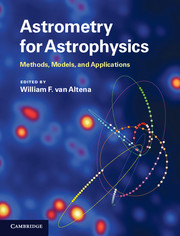Book contents
- Frontmatter
- Contents
- List of contributors
- List of acronyms
- Preface
- Part I Astrometry in the twenty-first century
- Part II Foundations of astrometry and celestial mechanics
- Part III Observing through the atmosphere
- Part IV From detected photons to the celestial sphere
- 13 Geometrical optics and astrometry
- 14 CCD imaging detectors
- 15 Using CCDs in the time-delay integration mode
- 16 Statistical astrometry
- 17 Analyzing poorly sampled images: HST imaging astrometry
- 18 Image deconvolution
- 19 From measures to celestial coordinates
- 20 Astrometric catalogs: concept, history, and necessity
- 21 Trigonometric parallaxes
- Part V Applications of astrometry to topics in astrophysics
- Index
- References
20 - Astrometric catalogs: concept, history, and necessity
from Part IV - From detected photons to the celestial sphere
Published online by Cambridge University Press: 05 December 2012
- Frontmatter
- Contents
- List of contributors
- List of acronyms
- Preface
- Part I Astrometry in the twenty-first century
- Part II Foundations of astrometry and celestial mechanics
- Part III Observing through the atmosphere
- Part IV From detected photons to the celestial sphere
- 13 Geometrical optics and astrometry
- 14 CCD imaging detectors
- 15 Using CCDs in the time-delay integration mode
- 16 Statistical astrometry
- 17 Analyzing poorly sampled images: HST imaging astrometry
- 18 Image deconvolution
- 19 From measures to celestial coordinates
- 20 Astrometric catalogs: concept, history, and necessity
- 21 Trigonometric parallaxes
- Part V Applications of astrometry to topics in astrophysics
- Index
- References
Summary
Introduction
A catalog is defined as a list of items, of some class, usually in systematic order, and with a description of each. In almost every catalog, it is possible to distinguish three types of data: primary, pseudoprimary, and secondary. For example, in a catalog devoted to large proper-motion stars, the primary data are the proper-motion data while spectral types or magnitudes or any additional information would be regarded as secondary data. In other words, secondary data complement the primary data. Pseudoprimary data are less important than the primary data, but for example may enable the user to uniquely identify the primary data.
The compilation of catalogs including positions, proper motions, and parallaxes is among the best-known activities of astrometry. In the early years of astronomy, providing positions of celestial bodies was a necessity for many of the ancient cultures. With roots dating back to the pre-Greek civilizations, astrometry provided the information for computing solar and lunar eclipses and the determination of time.
Catalogs and databases follow a recycling process in the sense that as new data or information are published, or better detectors become available, new comparisons, improved coordinates, proper motions, or parallaxes can be obtained. The catalogs that nowadays are considered obsolete were in earlier times widely used by the entire community and are now the basis for improved versions. In fact, probably more than any other science, astronomy is based on the analysis of data obtained through the years by different and generally unrelated research groups. Probably one of the best examples in this sense is the Astrographic Catalogue (see Section 20.3 below).
- Type
- Chapter
- Information
- Astrometry for AstrophysicsMethods, Models, and Applications, pp. 297 - 308Publisher: Cambridge University PressPrint publication year: 2012



